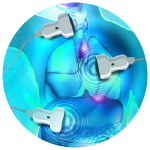Introduction
A 58 year-old male involved in a motor vehicle accident suffered multiple fractures and a lacerated spleen.The patient was sent to the OR for surgery and transferred to the ICU. The patient became unstable within hours despite the large volume of resuscitation in the OR: HR120 BPM, BP 90, lactate 3.5.
The Patient
A 58 year old male was involved in a 2-car, head–on MVC and was brought emergently to our trauma center. The patient was awake, alert and oriented with tachycardia in the 120’s but otherwise stable vital signs on primary assessment. He complained of left hip pain and had an obvious deformity to the right ankle. Radiography revealed a small spleen laceration, a complex left Tab fracture with an associated pelvic hematoma and a tib/fib fracture with distraction of the right ankle.
Procedure
The patient received approximately 2 liters of crystalloid in the trauma bay and during his work up. The patient was taken to the operating room with orthopedics where he underwent ORIF of his tib/fib fracture and stabilization of tab fracture. Intra-operatively, the patient was tachycardic (HR 120+ BPM) with softening systolic blood pressure in the mid 90’s. A lactic acid was drawn and returned as 3.5. The anesthesia report described infusions of 2U PRBC, 5 liters crystalloid, 2 amps Bicarb, and 1 amp calcium gluconate with only 125 cc’s of recorded intra-operative blood loss. Repeat H/H was stable from admission values.
The patient was transferred to the ICU and remained intubated. Despite the seemingly large volume of resuscitation the patient received in the operating room he remained tachycardic (HR 120-130’s) with systolic blood pressure in the mid-90’s.
hTEE Probe Placed
An hTEE probe was placed to assist with volume status evaluation and cardiac function assessment in order to guide his resuscitation.
hTEE Exam I
The mid-esophageal view revealed a tiny right ventricular chamber and hyperdynamic cardiac wall motion. The SVC view demonstrated a very collapsible and thin SVC (Figure 1), indicative of volume responsiveness. The transgastric view showed a left ventricular chamber with hyperdynamic wall-to-wall motion.
Volume Resuscitation and Response
Volume replacement was begun with crystalloid infusions. Surveillance laboratory draws revealed a drift in his hemoglobin from 12.5 to 10. FAST exam was negative for free intra abdominal fluid. Expecting a discrepancy in the actual intro-operative blood loss and that recorded, 2 UPRBCs were transfused. A total of 4 liters of crystalloid and 2 U of PRBCs were infused over a 6 hour time period. The patient’s heart rate slowed to the low 100’s. Repeat hTEE was performed.
hTEE Exam II
Repeat hTEE was performed. The mid-esophageal view demonstrated more adequate filling of his right ventricle. The transgastric view demonstrated better LV filling. The SVC view showed a more volume replete SVC with less collapsibility.
Resolution
The patient was weaned from sedation, weaned from the ventilator and extubated successfully on POD 3.





